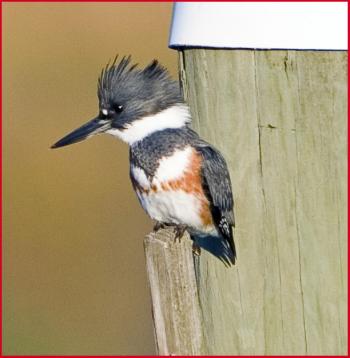The Bird Who Would Be King
Kingfishers are cool birds. Even the name is interesting: the king of fishers! Worldwide there are at least 87 different species of kingfisher (possibly more depending on how some island-specific forms are counted) and the majority of them are not fish eaters. There are the absurdly long-tailed, bright orange-billed paradise kingfishers of Papua New Guinea, and those famously loud, laughing kookaburra kingfishers of Australia. Many live in dry environments or forests and eat mostly insects, spiders, and other arthropods. Others eat lizards, snakes, mice, and even small birds. In fact, our own belted kingfisher that people think of as eating a strict fish diet will opportunistically take insects, lizards, small mammals, and, yes, other birds.
Belted kingfishers are a widespread bird in North America, breeding throughout almost the entire continent except for the northernmost open tundra of Alaska and Canada; the hot, southernmost extremes of the southwestern U.S and Mexico, and the southern tip of Florida. From southern Texas south into Mexico, the similar ringed kingfisher and the much smaller green kingfisher replace the belted kingfisher as the common breeding kingfisher species. But at least the northernmost of the belted kingfisher population migrates south, since the birds cannot survive in areas where the water is frozen. These south-bound migrants spend the winter in the Caribbean, Mexico, Central America, and, more sparingly, into northern South America. We have found them to be quite common in winter on the island of Aruba, just off the coast of Venezuela.
But a few of them are hardier, spending the winters along our coastline and, on the Pacific Coast, all the way into Alaska! Surprisingly, we found one a week or so ago along Cobbosseecontee Stream in Gardiner looking for fish in one of the only remaining areas of unfrozen freshwater in the region. Presumably a bird hanging on in these little patches is able to fly down to the coast in a few hours if a spell of cold weather freezes everything solid.
Belted kingfishers are fascinating in many ways, including in their nest habits. In the summer, they build a long burrow in a dirt or sand bank with a little cavity at the end where they lay their 5-8 eggs. Both parents incubate the eggs, the female apparently almost always taking the overnight shift. The eggs hatch at just over three weeks. Then it is another month before the chicks are able to leave the burrow and another three weeks before they are capture their own food and become independent. For a relatively small bird, it is a long rearing period, presumably in part because of the complicated nature of learning to capture fish.
It is their loud rattling call that typically gives them away. Probably many of you have experienced, as we have, the sound of a kingfisher echoing in across a still bay or lake in the early morning hours as it patrols its favorite feeding spots. Or you’ve watched one sitting on a branch overhanging the water or maybe a post on the end of a wharf as it surveyed the stills, hoping for a small fish near the surface to catch for a meal.
We think this hardy and fascinating bird is worthy of the title “king of the fishers,” and why it’s also one of Maine’s favorite birds.
Jeffrey V. Wells, Ph.D., is a Fellow of the Cornell Lab of Ornithology. Dr. Wells is one of the nation's leading bird experts and conservation biologists, and author of “Birder’s Conservation Handbook.” His grandfather, the late John Chase, was a columnist for the Boothbay Register for many years. Allison Childs Wells, formerly of the Cornell Lab of Ornithology, is a senior director at the Natural Resources Council of Maine, a statewide nonprofit membership organization working to protect the nature of Maine. Both are widely published natural history writers and coauthors of the book, “Maine’s Favorite Birds.”





























.png)
.png)
